NCERT Class 10 Chapter 6: TrianglesExercise 6.11. Fill in the blanks using the correct word given in brackets :
Solution
2. Give two different examples of pair of
Solution
3. State whether the following quadrilaterals are similar or not: 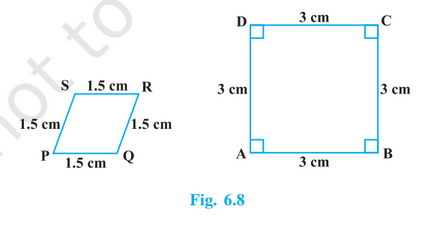
Solution In the quadrilateral ABCD, all the angles are 90°. However, in the quadrilateral PQRS, the angles are not equal to 90°. Hence, the given quadrilaterals are not similar. Exercise 6.21. In Fig. 6.17, (i) and (ii), DE || BC. Find EC in (i) and AD in (ii). 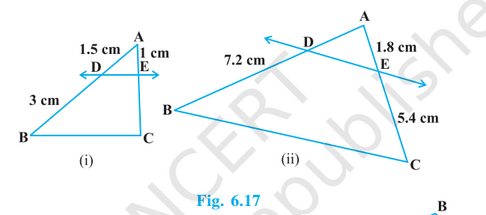
Solution (i) It is given that in ∆ABC, DE ‖ BC. Therefore, by using the basic proportionality theorem, we have: 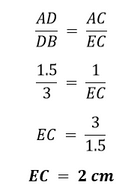
(ii) It is given that in ∆ABC, DE ‖ BC. Therefore, by using the basic proportionality theorem, we have: 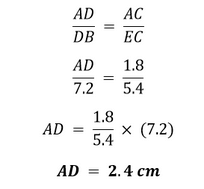
2. E and F are points on the sides PQ and PR respectively of a ∆ PQR. For each of the following cases, state whether EF || QR :
Solution I. EF ‖ QR, if the basic proportionality theorem is satisfied, i.e. 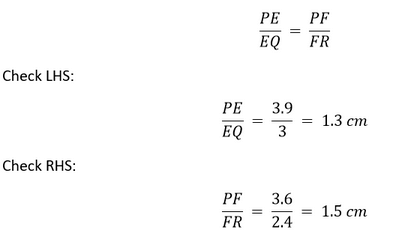
Since, LHS ≠ RHS, the theorem isn't satisfied. Hence, EF is not parallel to QR. II. EF ‖ QR, if the basic proportionality theorem is satisfied, i.e. 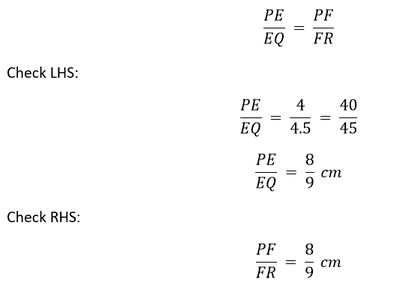
Since, LHS = RHS, the theorem is satisfied. Hence, EF is parallel to QR. III.EF ‖ QR, if the basic proportionality theorem is satisfied, i.e. 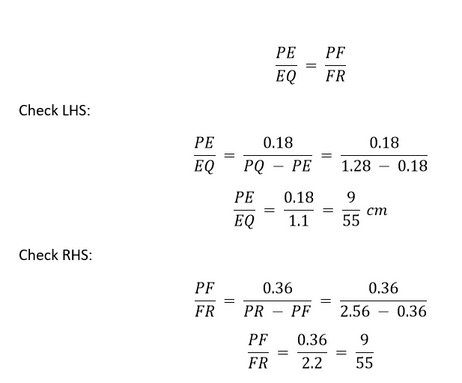
Since, LHS = RHS, the theorem is satisfied. Hence, EF is parallel to QR. 3. In Fig. 6.18, if LM || CB and LN || CD, prove that AM/AB = AN/AD. 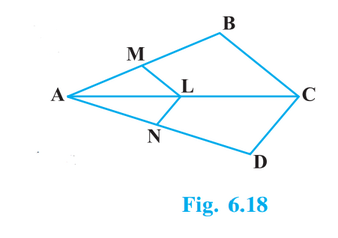
Solution It is given that LM is parallel to CB in ∆ABC, therefore: 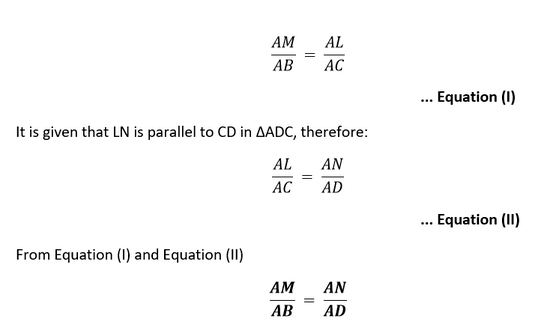
4. In Fig. 6.19, DE || AC and DF || AE. Prove that BF/FE = BE/EC. 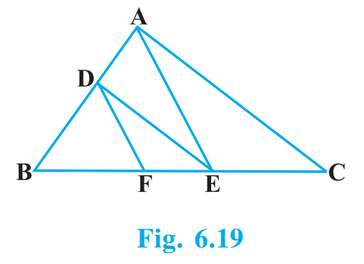
Solution 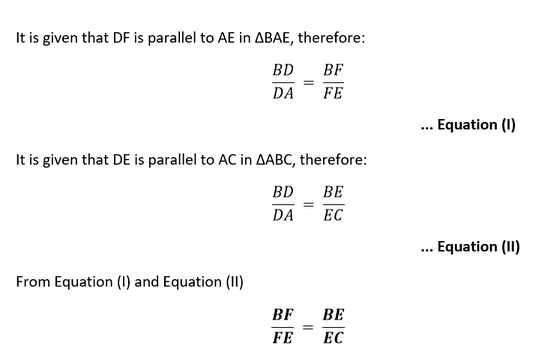
5. In Fig. 6.20, DE || OQ and DF || OR. Show that EF || QR. 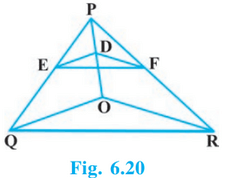
Solution 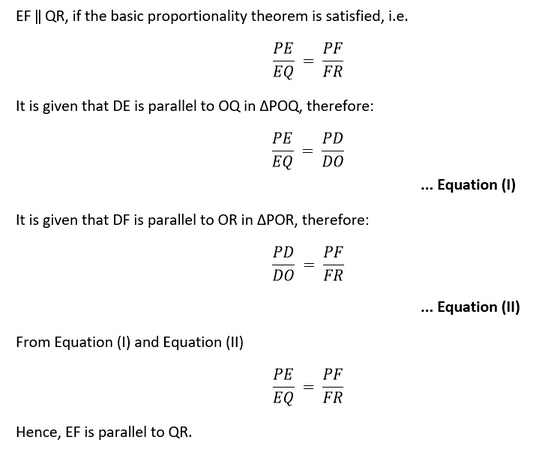
6. In Fig. 6.21, A, B and C are points on OP, OQ and OR respectively such that AB || PQ and AC || PR. Show that BC || QR. 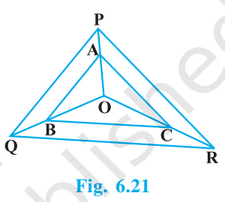
Solution 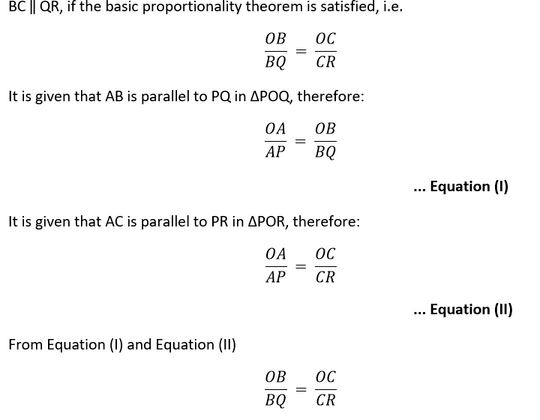
7. Using Theorem 6.1, prove that a line drawn through the mid-point of one side of a triangle parallel to another side bisects the third side. (Recall that you have proved it in Class IX). For reference:- Solution Let the triangle be ABC with DE as the line drawn through D as midpoint of side AB and E as a point on line AC. To Prove : AE = EC Proof : 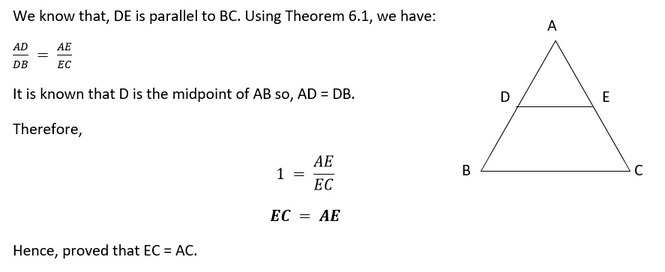
8. Using Theorem 6.2, prove that the line joining the mid-points of any two sides of a triangle is parallel to the third side. (Recall that you have done it in Class IX). For reference:- Solution Let the triangle be ABC, where DE is the line formed by joining the D which is the midpoint of AB and E which is the midpoint of AC. 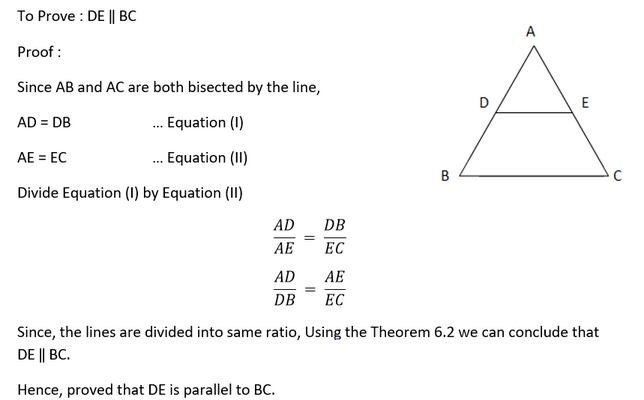
9. ABCD is a trapezium in which AB || DC and its diagonals intersect each other at the point O. Show that AO/BO = CO/DO. Solution 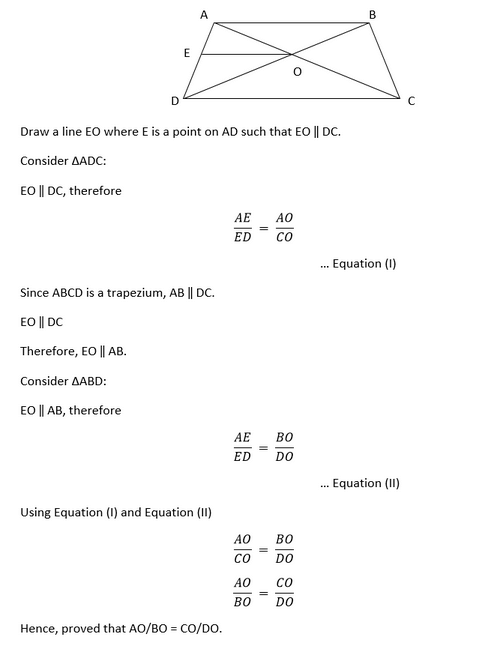
10. The diagonals of a quadrilateral ABCD intersect each other at the point O such that AO/BO = CO/DO. Show that ABCD is a trapezium. Solution 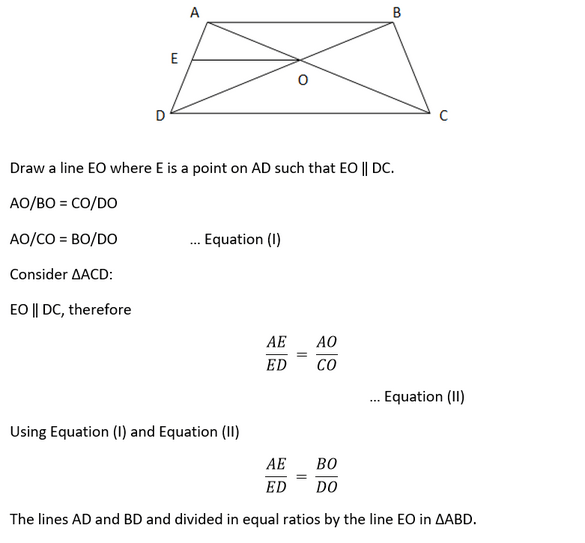
Therefore, by using the converse basic proportionality theorem we can conclude that EO ‖ AB. It is also known that EO ‖ CD, which implies that AB ‖ CD. Since two of the sides of the given quadrilateral are parallel, so it satisfies the condition for being a trapezium. Hence, ABCD is a trapezium. Exercise 6.31. State which pairs of triangles in Fig. 6.34 are similar. Write the similarity criterion used by you for answering the question and also write the pairs of similar triangles in the symbolic form : 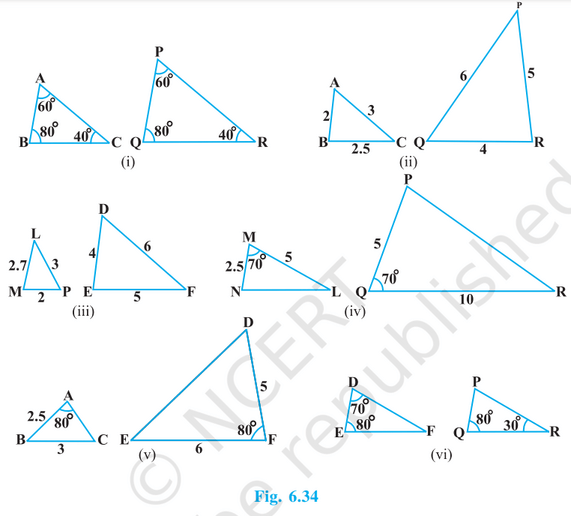
Solution (i) In ∆ABC and ∆PQR: 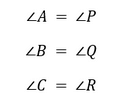
Hence, by AAA criterion ∆ABC ~ ∆PQR. (ii) In ∆ABC and ∆PQR: 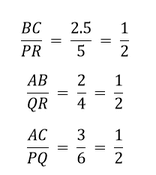
Hence, by SSS criterion ∆ABC ~ ∆PQR. (iii) In ∆MPL and ∆DEF: 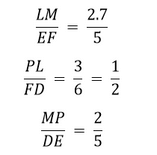
The ratios obtained are not same. Hence, ∆MPL is not similar to ∆DEF. (iv) In ∆LMN and ∆PQR: 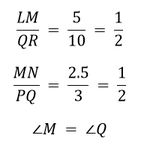
Hence, by SAS criterion ∆LMN ~ ∆PQR. (v) In ∆ABC and ∆DEF: 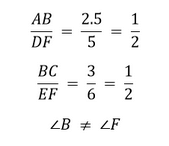
Hence, ∆ABC is not similar to ∆DEF. (vi) By Angle Sum property of a triangle, 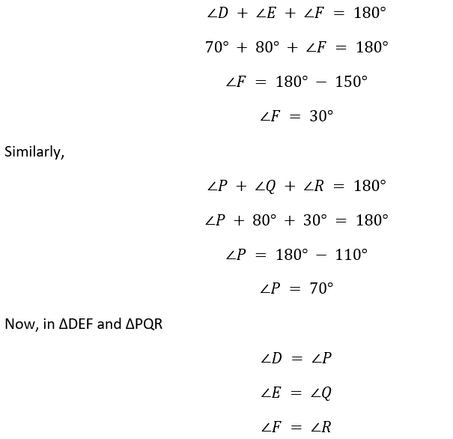
Hence, by AAA criterion ∆DEF ~ ∆PQR. 2. In Fig. 6.35, ∆ ODC ~ ∆ OBA, ∠ BOC = 125° and ∠ CDO = 70°. Find ∠ DOC, ∠ DCO and ∠ OAB. 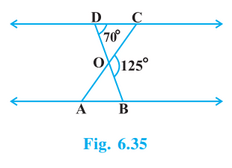
Solution ∠DOC and ∠BOC form a linear pair. Therefore 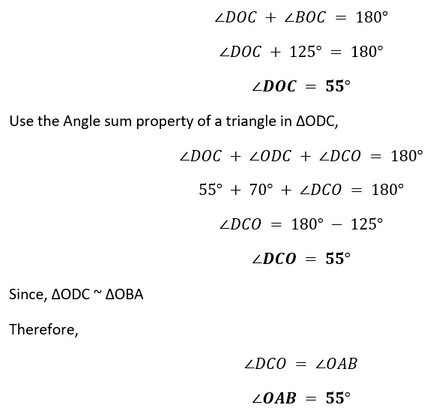
Hence ∠DOC = 55°, ∠DCO = 55° and ∠OAB = 55°. 3. Diagonals AC and BD of a trapezium ABCD with AB || DC intersect each other at the point O. Using a similarity criterion for two triangles, show that OA/OC = OB/OD. Solution 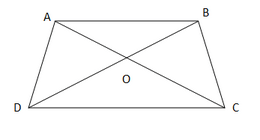
In ∆AOB and ∆COD, ∠BAO = ∠OCD (Alternate interior angles) ∠ABO = ∠ODC (Alternate interior angles) ∠AOB = ∠COD (Vertically opposite angles) Hence, by the AAA similarity criterion, ∆AOB ~ ∆COD. Since, ∆AOB ~ ∆COD Therefore, the corresponding sides will be proportional 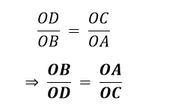
Hence, proved that OB/OD = OA/OC. 4. In Fig. 6.36, QR/QS = QT/PR and ∠ 1 = ∠ 2. Show that ∆ PQS ~ ∆ TQR. 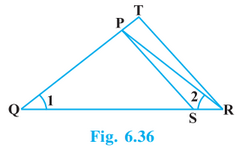
Solution In ∆PQR, ∠PQR = ∠PRQ Therefore, it is an isosceles triangle which implies that PQ = PR. 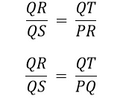
Using QR/QS = QT/PQ and ∠Q = ∠Q in ∆PQS and ∆TQR, we can conclude that the triangles are similar (by SAS similarity criterion). Hence, proved that ∆PQS ~ ∆TQR. 5. S and T are points on sides PR and QR of ∆ PQR such that ∠ P = ∠ RTS. Show that ∆ RPQ ~ ∆ RTS. Solution 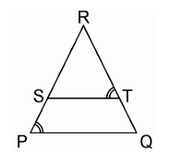
In ∆ RPQ and ∆ RTS, ∠RTS = ∠QPS (Given) ∠R = ∠R (Common Angle) Hence, by the AA similarity criterion ∆ RPQ ~ ∆ RTS. 6. In Fig. 6.37, if ∆ ABE ≅ ∆ ACD, show that ∆ ADE ~ ∆ ABC. 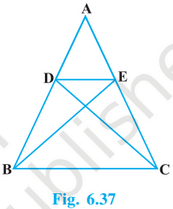
Solution In ∆ ABE and ∆ ACD AB = AC (Using c.p.c.t) ... Equation (I) AD = AE (Using c.p.c.t) ... Equation (II) 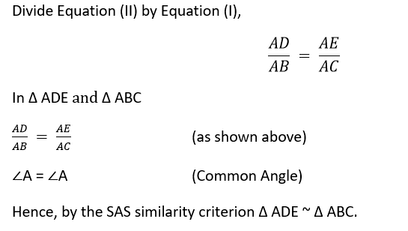
7. In Fig. 6.38, altitudes AD and CE of ∆ ABC intersect each other at the point P. Show that:
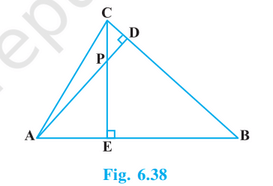
Solution I. In ΔAEP and ΔCDP, ∠AEP = ∠CDP (Right Angles) ∠APE = ∠CPD (Vertically Opposite Angles) Therefore, by AA similarity criterion ΔAEP ~ ΔCDP. II. In ΔABD and ΔCBE, ∠ADB = ∠CEB (Right Angles) ∠ABD = ∠CBE& (Common Angle) Therefore, by AA similarity criterion ΔABD ~ ΔCBE. III. In ΔAEP and ΔABD, ∠AEP = ∠ADB (Right Angles) ∠PAE = ∠DAB (Common Angle) Therefore, by AA similarity criterion ΔAEP ~ ΔABD. IV. In ΔPDC and ΔBEC, ∠PDC = ∠BEC (Right Angles) ∠PCD = ∠BCE (Common Angle) Therefore, by AA similarity criterion ΔPDC ~ ΔBEC. 8. E is a point on the side AD produced of a parallelogram ABCD and BE intersects CD at F. Show that ∆ ABE ~ ∆ CFB. 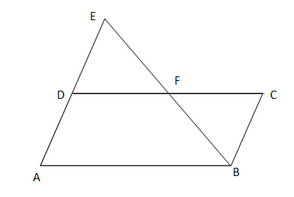
Solution In ∆ABE and ∆CFB, ∠BAE = ∠BCF (Opposite angles of a parallelogram) ∠ABE = ∠CFB (Alternate interior angles) Therefore, by AA similarity criterion ΔABE ~ ΔCFB. 9. In Fig. 6.39, ABC and AMP are two right triangles, right angled at B and M respectively. Prove that:
Solution 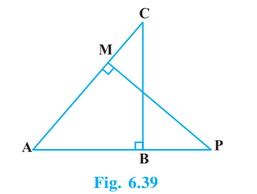
I. In ΔABC and ΔAMP, ∠ABC = ∠AMP (Right Angles) ∠BAC = ∠MAP (Common Angle) Therefore, by AA similarity criterion ΔABC ~ ΔAMP. II. Since, ∆ABC is similar to ∆AMP, their corresponding sides will have an equal ratio. Hence, 
10. CD and GH are respectively the bisectors of ∠ACB and ∠ EGF such that D and H lie on sides AB and FE of ∆ ABC and ∆ EFG respectively. If ∆ABC ~ ∆ FEG, show that:
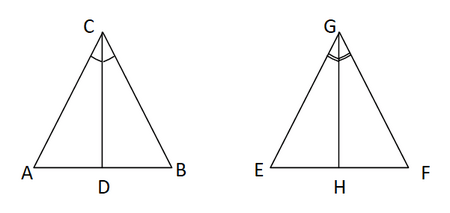
Solution It is given that ∆ABC ~ ∆ FEG, therefore ∠A = ∠F ∠B = ∠E ∠ACB = ∠FGE Divide both sides by 2 ∠ACB/2 = ∠FGE/2 ∠ACD = ∠FGH (Bisected Angles) I. Now, in ∆ACD and ∆FGH: ∠A = ∠F (As shown above) ∠ACD = ∠FGH (As shown above) Therefore, by the AA similarity criterion ∆ACD ~ ∆FGH. Which implies that 
II. Similarly, ∠DCB = ∠HGE In ∆DCB and ∆HGE: ∠B = ∠E (As Shown above) ∠DCB = ∠HGE (As shown above) Therefore, by the AA similarity criterion ∆DCB ~ ∆HGE. III. In ∆DCA and ∆HGF ∠A = ∠F (As shown above) ∠DCA = ∠HGF (As shown above) Therefore, by the AA similarity criterion ∆DCA ~ ∆HGF. 11. In Fig. 6.40, E is a point on side CB produced of an isosceles triangle ABC with AB = AC. If AD ⊥ BC and EF ⊥ AC, prove that ∆ ABD ~ ∆ ECF. 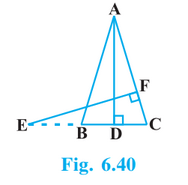
Solution In an isosceles triangles, angles opposite to equal sides are also equal. Therefore, ∠ABD = ∠ACD = ∠ECF In ∆ ABD and ∆ ECF: ∠ADB = ∠EFC (Right Angles) ∠ABD = ∠ECF (As Shown above) Therefore, by the AA similarity criterion ∆ ABD ~ ∆ ECF. 12. Sides AB and BC and median AD of a triangle ABC are respectively proportional to sides PQ and QR and median PM of ∆ PQR (see Fig. 6.41). Show that ∆ ABC ~ ∆ PQR. 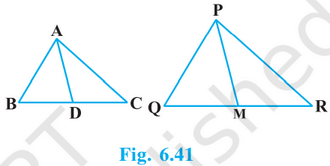
Solution It is given that 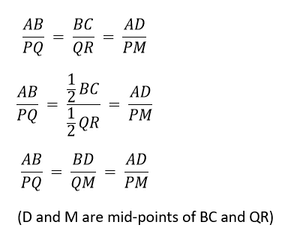
Therefore, by the SSS similarity criterion, ∆ABD ~ ∆PQM. This implies that ∠ABD = ∠PQM (Corresponding angles of similar triangles) ∠ABC = ∠PQR In ∆ABC and ∆PQR AB/PQ = BC/QR (Given) ∠ABC = ∠PQR (As shown above) Hence, by the SAS similarity criterion ∆ABC ~ ∆PQR. 13. D is a point on the side BC of a triangle ABC such that ∠ADC = ∠ BAC. Show that CA2 = CB.CD. 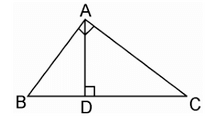
Solution In ∆ADC and ∆BAC: ∠ADC = ∠BAC (Given) ∠ACD = ∠BCA (Common Angles) Therefore, by the AA similarity criterion ∆ADC ~ ∆BAC. This implies that CA/CB = CD/CA (Corresponding sides of similar triangles) CA2 = CB.CD 14. Sides AB and AC and median AD of a triangle ABC are respectively proportional to sides PQ and PR and median PM of another triangle PQR. Show that ∆ABC ~ ∆ PQR. Solution 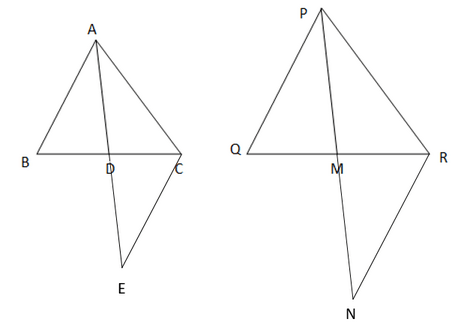
First, we will produce AD and PM lines to exterior points E and N respectively such that AD = DE and PM = MN, then join E and N with C and R respectively. In ∆ABD and ∆CDE: . ∠ADB = ∠ CDE (Vertically opposite angles) AD = DE (By construction) BD = DC (D is the mid-point of BC) Therefore, by the SAS congruency criterion ∆ABD ≅ ∆CDE. This implies that AB = CE (By c.p.c.t.) In ∆PQM and ∆MNR: . ∠PMQ = ∠NMR (Vertically opposite angles) PM = MN (By construction) QR = MR (M is the mid-point of QR) Therefore, by the SAS congruency criterion ∆PMQ ≅ ∆NMR. This implies that PQ = RN (By c.p.c.t.) It is given that 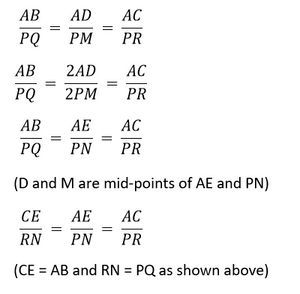
Therefore, by the SSS similarity criterion ∆ACE ~ ∆PRN. This implies that ∠CAE = ∠RPN (Corresponding angles of similar triangles) ∠CAD = ∠RPM Similarly, ∠BAD = ∠QPM. Add both the above equations ∠CAD + ∠BAD = ∠RPM + ∠QPM ∠BAC = ∠QPR In ∆ABC and ∆PQR: ∠BAC = ∠QPR (As shown above) AB/PQ = AC/PR (Given) Hence, by the SAS similarity criterion ∆ABC ~ ∆PQR. 15. A vertical pole of length 6 m casts a shadow 4 m long on the ground and at the same time a tower casts a shadow 28 m long. Find the height of the tower. Solution Let AB be the pole whose shadow is BC and let the tower be PQ with QR as the shadow. If we connect the top of pole and tower to the end of their respective shadows, we can obtain triangles ABC and PQR. 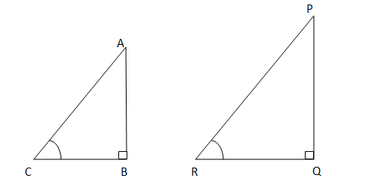
Since, the shadows BC and QR are being cast at the same time, the sun's elevation will be the same. Therefore, ∠ACB = ∠PRQ In ∆ABC and ∆PQR: ∠ACB = ∠PRQ (As shown above) ∠ABC = ∠PQR (Right Angles) Therefore, by the AA similarity criterion ∆ABC ~ ∆PQR. This implies that AB/PQ = BC/QR (Corresponding sides of similar triangles) AB = 6 m, BC = 4 m QR = 28 m 6/PQ = 4/28 6/PQ = 1/7 PQ = 42 m Hence, the height of the tower is 42 m. 16. If AD and PM are medians of triangles ABC and PQR, respectively where ∆ ABC ~ ∆ PQR, prove that AB/PQ = AD/PM. Solution 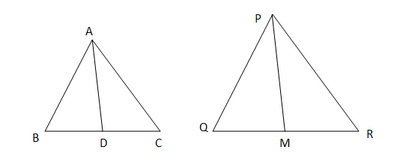
It is given that ∆ ABC ~ ∆ PQR, which implies that ∠ABC = ∠PQR (Corresponding Angles of similar triangles) ∠ABD = ∠PQM 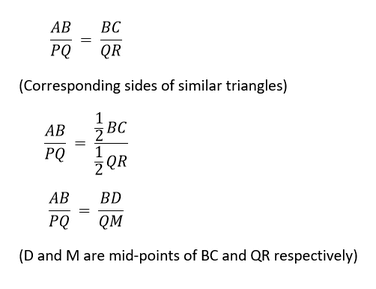
In ∆ABD and ∆PQM: AB/PQ = BD/QM (As shown above) ∠ABD = ∠PQM (As shown above) Therefore, by the SAS similarity criterion ∆ABD ~ ∆PQM. This implies that AB/PQ = AD/PM (Corresponding sides of similar triangles) Hence, proved that AB/PQ = AD/PM. Exercise 6.41. Let ∆ ABC ~ ∆ DEF and their areas be, respectively, 64 cm2 and 121 cm2. If EF = 15.4 cm, find BC. Solution Since ∆ ABC ~ ∆ DEF, therefore 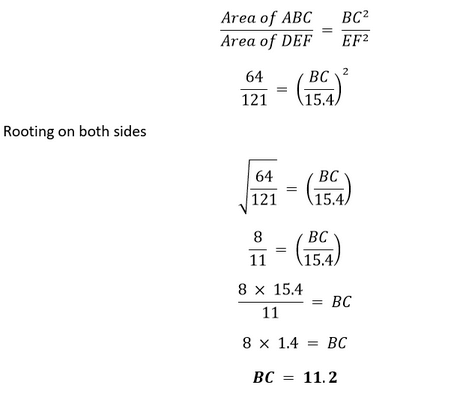
Hence, BC = 11.2 cm2. 2. Diagonals of a trapezium ABCD with AB || DC intersect each other at the point O. If AB = 2 CD, find the ratio of the areas of triangles AOB and COD. SOLUTION 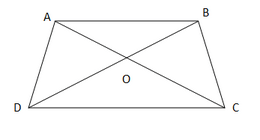
In ∆AOB and ∆COD: ∠AOB = ∠COD (Vertically opposite angles) ∠ABO = ∠CDO (Alternate interior angles) Therefore, by the AA similarity criterion ∆AOB ~ ∆COD. This implies that 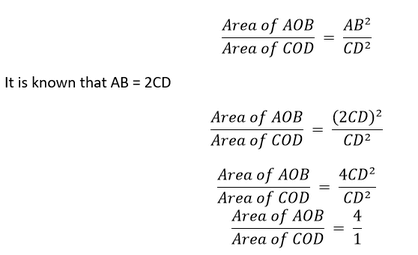
Hence, the ratio of the areas of triangles AOB and COD is 4 : 1. 3. In Fig. 6.44, ABC and DBC are two triangles on the same base BC. If AD intersects BC at O, show that ar (ABC)/ar (DBC) = AO/DO. 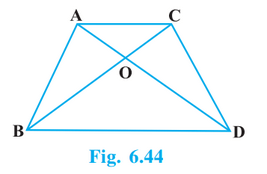
Solution We need to construct two lines AP and DM where P and M are points on BC such that AP and DM are perpendicular to BC. 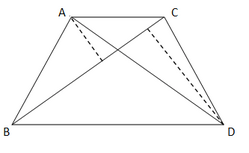
Area of triangle = ½ × Base × Altitude Area of ∆ABC = ½ × BC × AP Area of ∆DBC = ½ × BC × DM Ratio of Areas of ∆ABC and ∆DBC = (½ × BC × AP)/ (½ × BC × DM) ar (∆ABC)/ ar (∆DBC) = AP/DM ... Equation (I) In ∆AOP and ∆DOM: ∠AOP = ∠DOM (Vertically opposite angles) ∠APO = ∠DMO& (Right Angles) Therefore, by the AA similarity criterion ∆AOP ~ ∆DOM. This implies that AO/DO = PA/MD (Corresponding sides of similar triangles) AO/DO = AP/DM ... Equation (II) From Equation (I) and Equation (II), ar (∆ABC)/ ar (∆DBC) = AO/DO 4. If the areas of two similar triangles are equal, prove that they are congruent. Solution Let there be two similar triangles ABC and PQR where Area of ABC = Area of PQR. 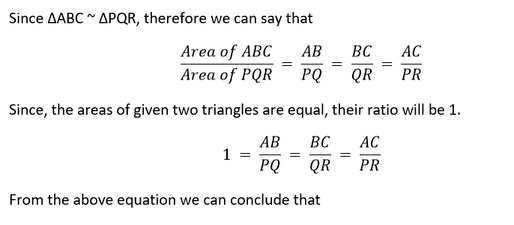
AB/PQ = 1 AB = PQ Similarly, BC = QR AC = PR Therefore, by the SSS congruency criteria ∆ABC ≅ ∆PQR. Hence, proved that two similar triangles with equal areas are congruent. 5. D, E and F are respectively the mid-points of sides AB, BC and CA of ∆ ABC. Find the ratio of the areas of ∆ DEF and ∆ ABC. Solution 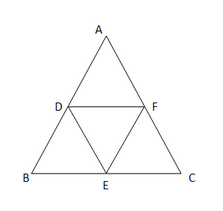
Since D and F are mid-points of sides AB and AC, therefore, by the mid-point theorem DF ‖ BC. In ∆ABC and ∆ADF: ∠BAC = ∠DAF (Common Angles) ∠ABC = ∠ADF (Corresponding Angles) Therefore, by the AA similarity criterion ∆ABC ~ ∆ADF. This implies that 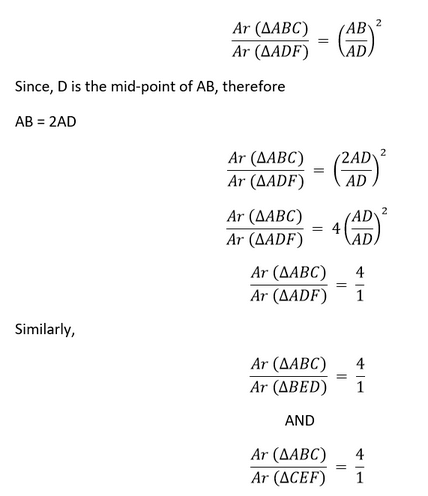
From the above equations, we can conclude that Ar (∆ADF) = �(Ar (∆ABC)) Ar (∆BED) = �(Ar (∆ABC)) Ar (∆CEF) = �(Ar (∆ABC)) Now, 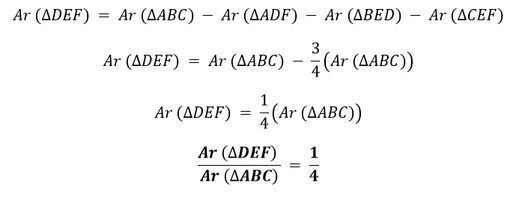
Hence, the ratio of the areas of triangles DEF and ABC is 1 : 4. 6. Prove that the ratio of the areas of two similar triangles is equal to the square of the ratio of their corresponding medians. Solution 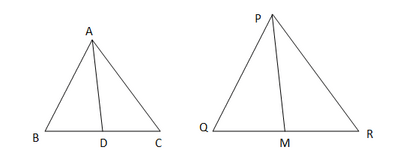
Let there be two similar triangles ABC and PQR, where AD and PM are the respective medians of the triangles. To Prove : ar (∆ABC)/ ar (∆PQR) = AD2/ PM2 Proof : It is given that ∆ABC ~ ∆PQR, which implies that ∠ABC = ∠PQR (Corresponding angles of similar triangles) ∠ABD = ∠PQM 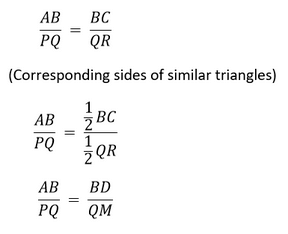
Now, in ∆ABD and ∆PQM: ∠ABD = ∠PQM (As shown above) AB/PQ = BD/QM (As shown above) Therefore, by the SAS similarity criterion ∆ABD ~ ∆PQM. This implies that 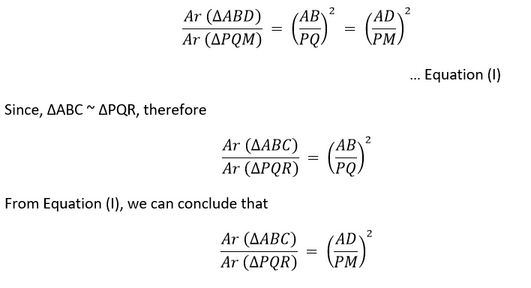
Hence, proved that ratio of the areas of two similar triangles is equal to the square of the ratio of their corresponding medians. 7. Prove that the area of an equilateral triangle described on one side of a square is equal to half the area of the equilateral triangle described on one of its diagonals. Solution Let there be a square ABCD with equilateral triangles ABD and ACE described on its one side and one diagonal. To Prove : ar (∆ABD) = ½ (ar (∆ACE)) 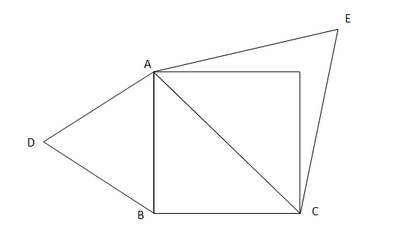
Proof : By using the Pythagoras theorem in ABC, we get: AC2 = AB2 + BC2 AB = BC as ABCD is a square AC2 = 2AB2 ... Equation (I) It is known that ABD and ACE are both equilateral triangles. Therefore, by the AAA similarity criterion ∆ABD ~ ∆ACE. This implies that 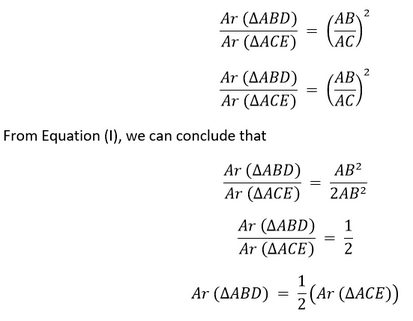
Hence, proved that the area of an equilateral triangle described on one side of a square is equal to half the area of the equilateral triangle described on one of its diagonals. Tick the correct answer and justify:8. ABC and BDE are two equilateral triangles such that D is the mid-point of BC. Ratio of the areas of triangles ABC and BDE is (A) 2 : 1 (B) 1 : 2 (C) 4 : 1 (D) 1 : 4 Solution 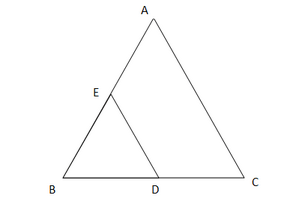
D is the mid-point of BC, therefore BD = DC = ½(BC) ... Equation (I) AB = BC (Sides of an equilateral triangle) ... Equation (II) Since, ∆ABC and ∆BDE are both equilateral triangles, therefore by the AAA similarity criterion ∆ABC ~ ∆BDE. This implies that 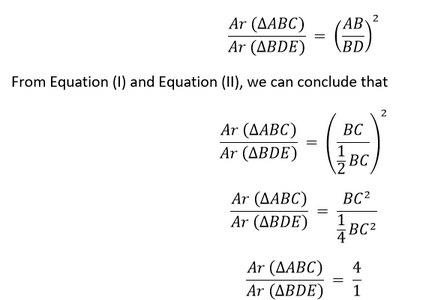
Hence, the correct answer is (C) 4 : 1. 9. Sides of two similar triangles are in the ratio 4 : 9. Areas of these triangles are in the ratio (A) 2 : 3 (B) 4 : 9 (C) 81 : 16 (D) 16 : 81 Solution Let there be two similar triangles ABC and DEF. Then, according to question 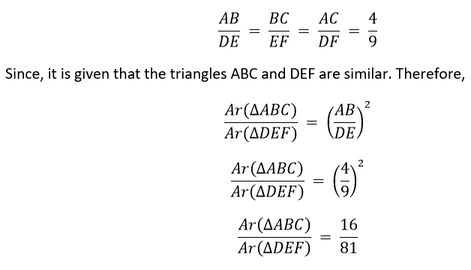
Since, it is given that the triangles ABC and DEF are similar. Therefore, Hence, the correct answer is (D) 16 : 81. Exercise 6.51. Sides of triangles are given below. Determine which of them are right triangles. In case of a right triangle, write the length of its hypotenuse.
Solution I. Squares of the smaller two sides = 72 + 242 = 49 + 576 = 625 cm2 Square of the longest side = 252 = 625 cm2 Therefore, the triangle satisfies the Pythagoras theorem and is a right angled triangle. The length of hypotenuse of this triangle is 25 cm. II. Squares of the smaller two sides = 32 + 62 = 9 + 36 = 45 cm2 Square of the longest side = 82 = 64 cm2 Therefore, the triangle does not satisfy the Pythagoras theorem and is not a right angled triangle. III. Squares of the smaller two sides = 502 + 802 = 2500 + 6400 = 8900 cm2 Square of the longest side = 1002 = 10000 cm2 Therefore, the triangle does not satisfy the Pythagoras theorem and is not a right angled triangle. IV. Squares of the smaller two sides = 52 + 122 = 25 + 144 = 169 cm2 Square of the longest side = 132 = 169 cm2 Therefore, the triangle satisfies the Pythagoras theorem and is a right angled triangle. The length of hypotenuse of this triangle is 13 cm. 2. PQR is a triangle right angled at P and M is a point on QR such that PM ⊥ QR. Show that PM2 = QM . MR. Solution 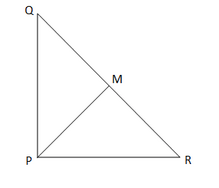
By using Pythagoras Theorem in ∆PQM, we get PQ2 = PM2 + QM2 PM2 = PQ2 - QM2 ... Equation (I) By using Pythagoras Theorem in ∆PRM, we get PR2 = PM2 + MR2 PM2 = PR2 - MR2 ... Equation (II) Add Equation (I) and Equation (II) 2PM2 = PQ2 - QM2 + PR2 - MR2 2PM2 = (PQ2 + PR2) - (QM2 + MR2) 2PM2 = (QR2) - (QM2 + MR2) [PQ2 + PR2 = QR2 by Pythagoras Theorem] 2PM2 = QR2 - QM2 - MR2 2PM2 = (QM + MR)2 - QM2 - MR2 [QR = QM + MR] 2PM2 = QM2 + MR2 + 2QM.MR - QM2 - MR2 2PM2 = 2QM.MR PM2 = QM.MR Hence, proved that PM2 3. In Fig. 6.53, ABD is a triangle right angled at A and AC ⊥ BD. Show that
Solution 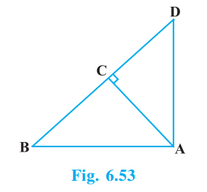
I. In ∆ABD and ∆CBA: ∠BAD = ∠BCA (Right Angles) ∠ABD = ∠ABC (Common Angles) Therefore, by the AA similarity criterion ∆ABD ~ ∆CBA. This implies that AB/CB = BD/AB (Corresponding Sides of similar triangles) AB2 = BC.BD II. Since, we have proven that ∆ABD ~ ∆CBA, therefore ∠CAB = ∠BDA (Corresponding angles of similar triangles) ∠CAB = ∠CDA In ∆CBA and ∆CAD: ∠ACB = ∠ACD (Right Angles) ∠CAB = ∠CDA (As shown above) Therefore, by the AA similarity criterion ∆CBA ~ ∆CAD. This implies that AC/BC = DC/AC (Corresponding Sides of similar triangles) AC2 = BC.DC III. In ∆DCA and ∆DAB: ∠DCA = ∠DAB (Right Angles) ∠CDA = ∠ADB (Common Angles) Therefore, by the AA similarity criterion ∆DCA ~ ∆DAB. This implies that CD/AD = AD/BD (Corresponding Sides of similar triangles) AD2 = BD.CD 4. ABC is an isosceles triangle right angled at C. Prove that AB2 = 2AC2 . Solution 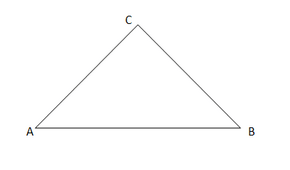
It is given that ∆ABC is an isosceles triangle. This implies that the sides opposite to the equal angles are equal. Since, ∠ACB is given to be the right angle. Therefore, ∠ABC and ∠BAC are the equal angles with sides AC = BC. By using Pythagoras Theorem in ABC, we get AB2 = AC2 + BC2 AB2 = AC2 + AC2 AB2 = 2AC2 Hence, proved that AB2 = 2AC2. 5. ABC is an isosceles triangle with AC = BC. If AB2 = 2 AC2 , prove that ABC is a right triangle. Solution 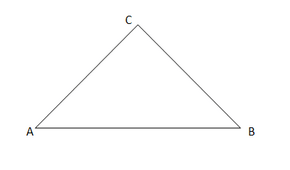
It is given that AB2 = 2AC2 AB2 = AC2 + AC2 AB2 = AC2 + BC2 (Since AC = BC is given) The above equation satisfies the Pythagoras Theorem. Hence, ∆ABC is a right angles triangle. 6. ABC is an equilateral triangle of side 2a. Find each of its altitudes. Solution Let us draw the altitude AD in the triangle ABC. 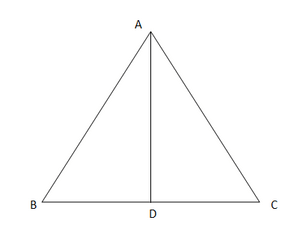
In ∆ADB and ∆ADC: ∠ADB = ∠ADC (Right Angles) AD = AD (Common Side) AB = AC (Sides of equilateral triangle ABC) Therefore, by the RHS congruency criteria ∆ADB ≅ ∆ADC. This implies that BD = CD (By c.p.c.t.) Therefore, BC = 2BD BD = BC/2 BD = a By applying Pythagoras theorem in ∆ADB, we get AB2 = BD2 + AD2 AD2 = AB2 - BD2 AD2 = 4a2 - a2 AD2 = 3a2 AD = ?3a Hence, the length of each of the altitude of the triangle ABC is ?3a. 7. Prove that the sum of the squares of the sides of a rhombus is equal to the sum of the squares of its diagonals. Solution Let there be a rhombus ABCD whose diagonals bisect each other at O. 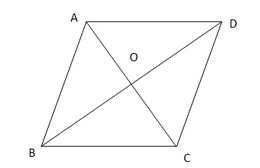
To Prove : AB2 + BC2 + CD2 + AD2 = AC2 + BD2 Proof : We know that the diagonals of a rhombus bisect each other at right angles. Therefore, AOB, AOD, BOC, COD are all right angles triangles. This also implies that AO = CO and BO = DO as O is the point of bisection. By applying Pythagoras Theorem to ∆AOB, we get AB2 = AO2 + BO2 Similarly, BC2 = BO2 + CO2 CD2 = CO2 + DO2 AD2 = AO2 + DO2 Adding all of the above obtained equations, we get AB2 + BC2 + CD2 + AD2 = AO2 + BO2 + BO2 + CO2 + CO2 + DO2 + AO2 + DO2 AB2 + BC2 + CD2 + AD2 = 2(AO2 + BO2 + CO2 + DO2) AB2 + BC2 + CD2 + AD2 = 2(AO2 + CO2 + BO2 + DO2) Since, AO = CO and BO = DO. Therefore, AB2 + BC2 + CD2 + AD2 = 2(2AO2 + 2BO2) AB2 + BC2 + CD2 + AD2 = 4AO2 + 4BO2 AB2 + BC2 + CD2 + AD2 = (2AO)2 + (2BO)2 O is the midpoint of AC and BD, so 2AO = AC and 2BO = BD. Therefore, >AB2 + BC2 + CD2 + AD2 = AC2 + BD2 Hence, proved that the sum of the squares of the sides of a rhombus is equal to the sum of the squares of its diagonals. 8. In Fig. 6.54, O is a point in the interior of a triangle ABC, OD ⊥ BC, OE ⊥AC and OF ⊥AB. Show that
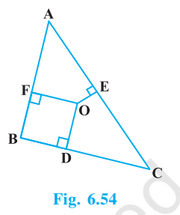
Solution Let us join OB, OA and OC. 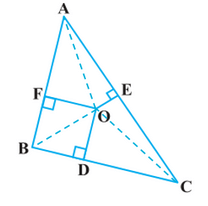
I. By applying Pythagoras Theorem in ∆AOF, we get OA2 = AF2 + OF2 By applying Pythagoras Theorem in ∆BOD, we get OB2 = OD2 + BD2 By applying Pythagoras Theorem in ∆COE, we get OC2 = OE2 + EC2 Adding the above obtained equations, we get OA2 + OB2 + OC2 = AF2 + OF2 + OD2 + BD2 + OE2 + EC2 OA2 + OB2 + OC2 - OD2 - OE2 - OF2 = AF2 + BD2 + EC2 Hence, proved. II. OA2 + OB2 + OC2 - OD2 - OE2 - OF2 = AF2 + BD2 + EC2 (OA2 - OE2) + (OC2 - OD2) + (OB2 - OF2) = AF2 + BD2 + EC2 By applying Pythagoras Theorem in ∆AOE, we get OA2 = OE2 + AE2 OA2 - OE2 = AE2 Similarly, OC2 - OD2 = CD2 OB2 - OF2 = BF2 Hence, (OA2 - OE2) + (OC2 - OD2) + (OB2 - OF2) = AF2 + BD2 + EC2 AE2 + CD2 + BF2 = AF2 + BD2 + EC2 9. A ladder 10 m long reaches a window 8 m above the ground. Find the distance of the foot of the ladder from base of the wall. Solution Let AB be the ladder which reaches the window at A with the base of the wall at C. 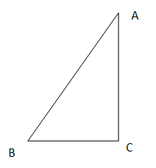
The wall will be perpendicular to the ground, therefore ABC will form a right triangle which is right angled at C. AB = 10 m , AC = 8m By applying Pythagoras Theorem in ABC, we get AB2 = AC2 + BC2 102 = 82 + BC2 100 = 64 + BC2 36 = BC2 BC = 6 m Hence, the distance between foot of the ladder and the base of the wall is 6 m. 10. A guy wire attached to a vertical pole of height 18 m is 24 m long and has a stake attached to the other end. How far from the base of the pole should the stake be driven so that the wire will be taut? Solution 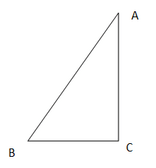
Let the wire be AB and the pole be AC. BC is the distance between the stake and base of the pole. ∆ACB is a right triangle which is right angled at C. By Applying Pythagoras Theorem in ABC, we get AB2 = AC2 + BC2 242 = 182 + BC2 576 - 324 = BC2 252 = BC2 BC = 6?7 m Hence, the stake needs to be driven 6?7 m away from the base of the pole to make the wire taut. 11. An aeroplane leaves an airport and flies due north at a speed of 1,000 km per hour. At the same time, another aeroplane leaves the same airport and flies due west at a speed of 1,200 km per hour. How far apart will be the two planes after 1*1/2 hours? Solution Let A be the current position of the plane flying to north and B be the current position of the plane flying to the west. Let O be the starting point for the two planes. 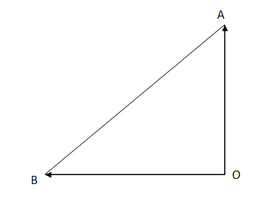
AOB will form a right triangle, right angled at O. Speed of plane going north = 1000 km/h 
= 1200 × 3/2 = 1800 km By Applying the Pythagoras theorem in AOB, we get AB2 = AO2 + BO2 AB2 = 15002 + 18002 AB2 = 2250000 + 3240000 AB2 = 5490000 AB = 300?61 km 
12. Two poles of heights 6 m and 11 m stand on a plane ground. If the distance between the feet of the poles is 12 m, find the distance between their tops. SOLUTION 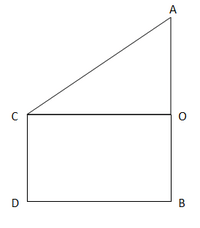
Let AB be the taller pole and CD be the smaller pole. The distance between their tops is AC and the distance between their feet is BD. We will draw an imaginary line from C to O which is a point on the pole AB such that OC ‖ BD. The poles stand perpendicular to the ground, so ∠BDC is a right angle. ∠AOC = ∠BDC (Corresponding Angles) Therefore, ∆AOC is a right triangle. OCBD forms a rectangle as OC ‖ BD and AB ‖ CD. This implies that OC = BD = 12 m OB = CD = 6 m Now, AB = AO + OB AO = AB - OB = 11 - 6 = 5 m By Applying Pythagoras Theorem in AOC, we get AC2 = AO2 + OC2 AC2 = 52 + 122 AC2 = 25 + 144 AC2 = 169 AC = 13 m Hence, the distance between the top of the two poles is 13 m. 13. D and E are points on the sides CA and CB respectively of a triangle ABC right angled at C. Prove that AE2 + BD2 = AB2 + DE2. 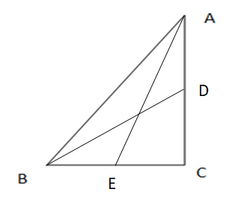
By Applying Pythagoras Theorem in ABC, we get AB2 = AC2 + BC2 ... Equation (I) By Applying Pythagoras Theorem in AEC, we get AE2 = AC2 + EC2 By Applying Pythagoras Theorem in BDC, we get BD2 = BC2 + DC2 By Applying Pythagoras Theorem in DEC, we get DE2 = DC2 + EC2 ... Equation (II) Therefore, AE2 + BD2 = AC2 + EC2 + BC2 + DC2 AE2 + BD2 = (AC2 + BC2) + (EC2 + DC2) From Equation (I) and Equation (II), we get AE2 + BD2 = AB2 + DE2 Hence, proved. 14. The perpendicular from A on side BC of a ∆ ABC intersects BC at D such that DB = 3 CD (see Fig. 6.55). Prove that 2 AB2 = 2 AC2 + BC2. 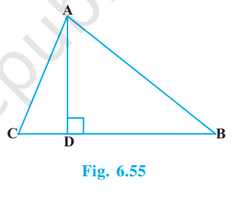
Solution BC = BD + CD BC = 3CD + CD BC/4 = CD By applying Pythagoras Theorem in ADB, we get AB2 = AD2 + BD2 ... Equation (I) By applying Pythagoras Theorem in ADC, we get AC2 = AD2 + CD2 ... Equation (II) Subtract Equation (II) from Equation (I): AB2 - AC2 = BD2 - CD2 AB2 - AC2 = (3CD)2 - CD2 AB2 - AC2 = 9CD2 - CD2 AB2 - AC2 = 8CD2 AB2 - AC2 = 8(BC/4)2 AB2 - AC2 = BC2/2 2(AB2 - AC2) = BC2 2AB2 - 2AC2 = BC2 2AB2 = 2AC2 + BC2 Hence, proved. 15. In an equilateral triangle ABC, D is a point on side BC such that BD = 1/3 BC. Prove that 9 AD2 = 7 AB2. Solution 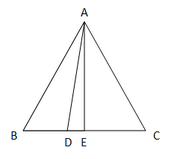
Let us construct altitude AE in ∆ABC. Since AE is the altitude of an equilateral triangle, therefore it will also act as a median. BE = CE = BC/2 By applying Pythagoras Theorem in ABE, we get AB2 = BE2 + AE2 AE2 = AB2 - BE2 AE2 = AB2 - BC2/4 By applying Pythagoras Theorem in ADE, we get AD2 = AE2 + DE2 AD2 = AE2 + (BE - BD)2 AD2 = AB2 - BC2/4 + (BC/2 - BC/3)2 AD2 = AB2 - BC2/4 + (BC/6)2 AD2 = AB2 - BC2/4 + BC2/36 AD2 = AB2 - 8BC2/36 AD2 = AB2 - 2BC2/9 AD2 = (9AB2 - 2BC2)/9 9AD2 = 9AB2 - 2AB2 (BC = AB as ABC is an equilateral triangle) 9AD2 = 7AB2 Hence, proved. 16. In an equilateral triangle, prove that three times the square of one side is equal to four times the square of one of its altitudes. Solution 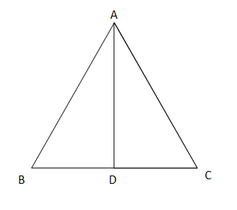
Let there be an equilateral triangle ABC with altitude AD and length of each side a. To prove : 3a2 = 4AD2 Proof : We know that the altitude of an equilateral triangle also acts as a median. Therefore, BD = CD = BC/2 By applying Pythagoras Theorem in ABD, we get AB2 = AD2 + BD2 AB2 = AD2 + BC2/4 a2 = AD2 + a2/4 3a2/4 = AD2 3a2 = 4AD2 Hence, proved that three times the square of one side is equal to four times the square of one of its altitudes. 17. Tick the correct answer and justify : In ∆ABC, AB = 6?3 cm, AC = 12 cm and BC = 6 cm. The angle B is : (A) 120° (B) 60° (C) 90° (D) 45° Solution AB2 = (6?3)2 = 108 AC2 = 122 = 144 BC2 = 62 = 36 It can be observed that AB2 + BC2 = 144 = AC2. This implies that the triangle satisfies the Pythagoras Theorem with AC as the hypotenuse. Therefore, angle B is 90°. Hence, correct options is (C) 90°. Exercise 6.6 (Optional)1. In Fig. 6.56, PS is the bisector of ∠ QPR of ∆ PQR. Prove that QS/SR = PQ/PR. 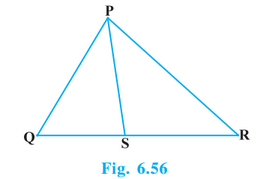
Solution Let us produce the line QP to an external point T such that TR is parallel to PS. 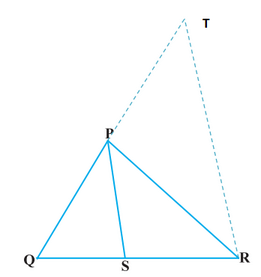
∠QPS = ∠SPR as PS is the angle bisector for ∠QPR. ∠QPS = ∠QTR (Corresponding Angles) ∠SPR = ∠PRT (Alternate Interior Angles) Therefore, ∠PRT = ∠QTR. We know that if two angles of a triangle are equal then the triangle is isosceles and sides opposite to the equal angles are also equal. Therefore, PT = PR By using the basic proportionality theorem in QRT, we get QS/SR = PQ/PT QS/SR = PQ/PR Hence, proved. 2. In Fig. 6.57, D is a point on hypotenuse AC of ∆ABC, such that BD ⊥AC, DM ⊥ BC and DN ⊥ AB. Prove that :
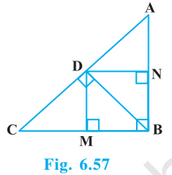
Solution It can be concluded from the figure that DBMN is a rectangle as its opposite sides are parallel and the angles are 90° each. This implies that DN = BM and DM = BN. (i). ∠CDM = ∠CDB - ∠BDM ∠CDM = 90° - ∠BDM ∠CDM + ∠BDM = 90° Also, in ∆CDM: ∠CDM + ∠CMD + ∠MCD = 180° ∠CDM + 90° + ∠MCD = 180° ∠CDM + ∠MCD = 90° Therefore, we can say that ∠CDM + ∠MCD = ∠CDM + ∠BDM (Both sides are equal to 90°) ∠MCD = ∠BDM In ∆CDM and ∆MDB: ∠MCD = ∠BDM (As shown above) ∠CMD = ∠BMD (Right Angles) Therefore, by the AA similarity criterion ∆CDM ~ ∆MDB. This implies that DM/BM = MC/DM DM2 = MC.BM We have already shown that BM = DN. DM2 = DN.MC (ii). ∠ADB = ∠ADN + ∠BDN ∠ADN + ∠BDN = 90° Also, in ∆ADN: ∠AND + ∠ADN + ∠DAN = 180° 90° + ∠ADN + ∠DAN = 180° ∠ADN + ∠DAN = 90° Therefore, we can say that ∠ADN + ∠DAN = ∠ADN + ∠BDN (Both sides equal to 90°) ∠DAN = ∠BDN In ∆ADN and ∆NDB: ∠DAN = ∠BDN (As shown above) ∠CMD = ∠BMD (Right Angles) Therefore, by the AA similarity criterion ∆ADN ~ ∆NDB. This implies that DN/BN = NA/DN DN2 = AN.BN We have already shown that BN = DM. DN2 = DM.AN Hence, proved. 3. In Fig. 6.58, ABC is a triangle in which ∠ABC > 90° and AD ⊥ CB produced. Prove that AC2 = AB2 + BC2 + 2 BC . BD. 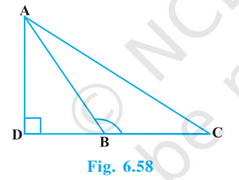
Solution By applying Pythagoras Theorem in ABD, we get AB2 = AD2 + BD2 By applying Pythagoras Theorem in ACD, we get AC2 = AD2 + CD2 AC2 = AD2 + (BD + BC)2 AC2 = AD2 + BD2 + BC2 + 2 BC.BD We already know that AD2 + BD2 = AB2, therefore AC2 = AB2 + BC2 + 2 BC.BD Hence, proved. 4. In Fig. 6.59, ABC is a triangle in which ∠ ABC < 90° and AD ⊥ BC. Prove that AC2 = AB2 + BC2 - 2 BC . BD. 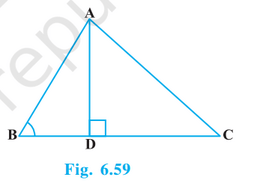
Solution By applying Pythagoras Theorem in ABD, we get AB2 = AD2 + BD2 By applying Pythagoras Theorem in ACD, we get AC2 = AD2 + CD2 AC2 = AD2 + (BC - BD)2 AC2 = AD2 + BD2 + BC2 - 2 BC.BD We already know that AD2 + BD2 = AB2, therefore AC2 = AB2 + BC2 - 2 BC.BD Hence, proved. 5. In Fig. 6.60, AD is a median of a triangle ABC and AM ⊥ BC. Prove that :
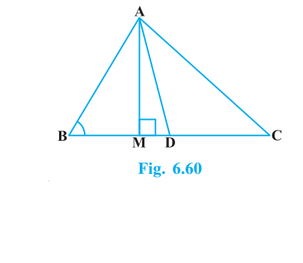
Solution It is given that AD is the median of triangle ABC, therefore BD = CD = BC/2 ... Equation (I) By applying Pythagoras Theorem in AMD, we get AD2 = AM2 + DM2 (i). By applying Pythagoras Theorem in ACM, we get AC2 = AM2 + CM2 AC2 = AM2 + (CD + DM)2 AC2 = AM2 + DM2 + CD2 + 2 CD.DM By Using Equation (I) AC2 = AM2 +DM2 + (BC/2)2 + 2(BC/2)DM We already know that AM2 + DM2 = AD2, therefore AC2 = AD2 + (BC/2)2 + 2(BC/2)DM AC2 = AD2 + BC .DM + (BC/2)2 (ii). By applying Pythagoras Theorem in ABM, we get AB2 = AM2 + BM2 We know that AD2 = AM2 + DM2 AM2 = AD2 - DM2 Now, AB2 = AD2 - DM2 + BM2 AB2 = AD2 - DM2 + (BD - DM)2 AB2 = AD2 - DM2 + BD2 + DM2 - 2BD.DM By Using Equation (I) AB2 = AD2 + (BC/2)2 - 2 (BC/2).DM AB2 = AD2 + (BC/2)2 - BC .DM (iii). By applying Pythagoras Theorem in ABM, we get AB2 = AM2 + BM2 By applying Pythagoras Theorem in AMC, we get AC2 = AM2 + MC2 Adding the above two equations, we get AB2 + AC2 = 2AM2 + BM2 + MC2 AB2 + AC2 = 2AM2 + (BD - DM)2 + (DM + CD)2 AB2 + AC2 = 2AM2 + BD2 + DM2 - 2 BD.DM + DM2 + CD2 + 2 DM.CD AB2 + AC2 = 2AM2 + 2DM2 + BD2 + CD2 + 2DM(CD - BD) AB2 + AC2 = 2(AM2 + DM2) + BD2 + CD2 + 2DM(CD - BD) We know that AM2 + DM2 = AD2, therefore AB2 + AC2 = 2AD2 + BD2 + CD2 + 2DM(CD - BD) By Using Equation (I) AB2 + AC2 = 2AD2 + (BC/2)2 + (BC/2)2 + 2DM(BC/2 - BC/2) AB2 + AC2 = 2AD2 + BC2/4 + BC2/4 AB2 + AC2 = 2AD2 + BC2/2 Hence, proved. 6. Prove that the sum of the squares of the diagonals of parallelogram is equal to the sum of the squares of its sides. Solution Let ABCD be a parallelogram with AB ‖ CD and altitude AE. We will produce BA to a point F such that DF ? BF. 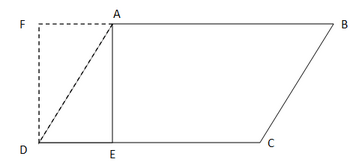
To Prove : AC2 + BD2 = AB2 + BC2 + CD2 + AD2 Proof : By applying Pythagoras Theorem in ADF, we get AD2 = AF2 + DF2 By applying Pythagoras Theorem in BDF, we get BD2 = BF2 + DF2 BD2 = (AB + AF)2 + DF2 BD2 = AB2 + AF2 + 2 AB.AF + DF2 We know that AF2 + DF2 = AD2, therefore BD2 = AB2 + AD2 + 2 AB.AF; ... Equation (I) By applying Pythagoras Theorem in ADE, we get AD2 = AE2 + DE2 By applying Pythagoras Theorem in ACE, we get AC2 = AE2 + CE2 AC2 = AE2 + (CD - DE)2 AC2 = AE2 + CD2 - 2 CD.DE + DE2 We know that AE2 + DE2 = AD2, therefore AC2 = AD2 + CD2 - 2 CD.DE ... Equation (II) Add Equation (I) and Equation (II) AC2 + BD2 = AD2 + CD2 - 2 CD.DE + AB2 + AD2 + 2 AB.AF Since ABCD is a parallelogram, therefore AB = CD and BC = AD (Opposite sides of a parallelogram) Also, it can be observed that AEDF forms a rectangle, which implies that AF = DE; (Opposite sides of a rectangle) Therefore, AC2 + BD2 = AD2 + CD2 + AB2 + BC2 + 2 AB.AF - 2 AB.AF AC2 + BD2 = AD2 + CD2 + AB2 + BC2 Hence, proved that the sum of the squares of the diagonals of parallelogram is equal to the sum of the squares of its sides. 7. In Fig. 6.61, two chords AB and CD intersect each other at the point P. Prove that :
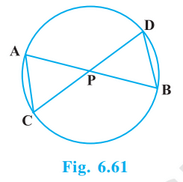
Solution AP = BP = CP = DP as they are radii of the given circle. Therefore, AP/DP = 1 = CP/BP. (i). In ∆APC and ∆DPB: AP/DP = CP/BP (As shown above) ∠APC = ∠DPB (Vertically opposite angles) Therefore, by the SAS similarity criterion ∆APC ~ ∆DPB. (ii). We have already shown that AP/DP = CP/BP. This implies that AP.BP = CP.DP AP.PB = PC.DP Hence, proved. 8. In Fig. 6.62, two chords AB and CD of a circle intersect each other at the point P (when produced) outside the circle. Prove that
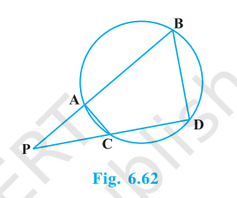
Solution (i). Since ABCD is a quadrilateral which is contained in a circle, therefore, ABCD forms a cyclic quadrilateral. This implies that, ∠PAC = ∠BDC (Exterior angle of a cyclic quadrilateral is equal to the opposite interior angle) In ∆PAC and ∆PDB: ∠PAC = ∠BDC (As shown above) ∠APC = ∠BPD (Common Angle) Therefore, by the AA similarity criterion ∆PAC ~ ∆PDB. (ii). We have already shown that ∆PAC ~ ∆PDB. This implies that AP/DP = PC/PB (Corresponding sides of similar triangles) AP.PB = PC.DP Hence, proved. 9. In Fig. 6.63, D is a point on side BC of ∆ ABC such that BD/CD = AB/AC. Prove that AD is the bisector of ∠ BAC. 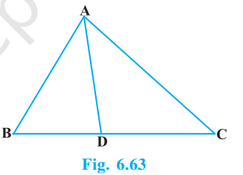
Solution 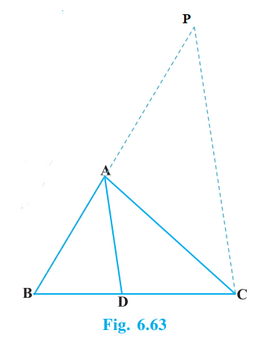
Let us produce BA to an external point P such that AP = AC. BC/ CD = AB/ AC (Given) BC/CD = AB/AP (AP = AC) Therefore, by using the converse of basic proportionality theorem, we can say that AD ‖ CP. ∠BAD = ∠APC (Corresponding Angles) ∠CAD = ∠ACP (Alternate Interior Angles) ∆ACP is an isosceles triangle as AP = AC. This implies that ∠APC = ∠ACP (Angles opposite to equal sides in an isosceles triangle) Therefore, ∠BAD = ∠CAD AD divides the ∠BAC in two equal parts. Hence, AD is the bisector of ∠BAC. 10. Nazima is fly fishing in a stream. The tip of her fishing rod is 1.8 m above the surface of the water and the fly at the end of the string rests on the water 3.6 m away and 2.4 m from a point directly under the tip of the rod. Assuming that her string (from the tip of her rod to the fly) is taut, how much string does she have out (see Fig. 6.64)? If she pulls in the string at the rate of 5 cm per second, what will be the horizontal distance of the fly from her after 12 seconds? 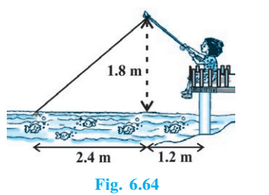
Solution The situation can be represented in form of a triangle ABC, where A is the tip of fishing rod, C is the end of the string and BC is the surface of water. 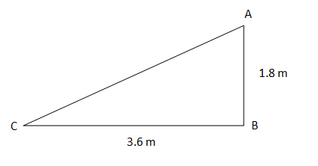
By applying Pythagoras theorem in ABC, we get AC2 = AB2 + BC2 AC2 = (1.8)2 + (2.4)2 AC2 = 3.24 + 5.76 AC2 = 9 AC = 3 Therefore, Nazima has 3 m of her fishing rod string out. It is given that she is pulling the string by 5 cm per second. Therefore, Length of string pulled by Nazima in 1 second = 5 cm Length of string pulled by Nazima in 12 seconds = 12 × 5 = 60 cm = 0.6 m Let the new position of the fly be D which is a point on the water surface BC. 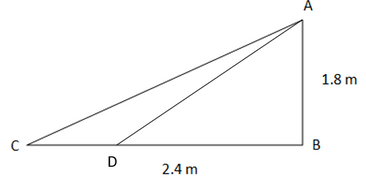
Length of string remaining out after 12 seconds = AD = 3 - 0.6 m = 2.4 m By applying Pythagoras Theorem in ABD, we get AD2 = AB2 + BD2 (2.4)2 = (1.8)2 + BD2 BD2 = (2.4)2 - (1.8)2 BD2 = 5.76 - 3.24 BD2 = 2.52 BD = 1.59 m (Approx.) Horizontal distance of the fly = 1.2 + BD = 1.2 + 1.59 = 2.79 m Hence, the fly is at a horizontal distance of 2.79 m (approx. value) from Nazima.
Next TopicClass 10 Maths Chapter 7
|
 For Videos Join Our Youtube Channel: Join Now
For Videos Join Our Youtube Channel: Join Now
Feedback
- Send your Feedback to [email protected]
Help Others, Please Share










